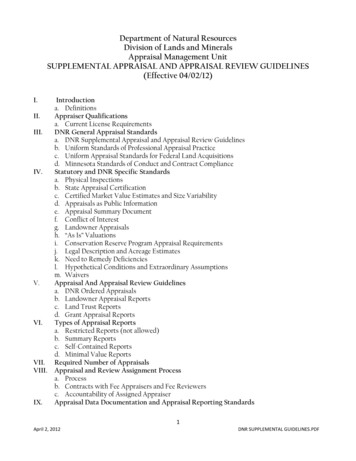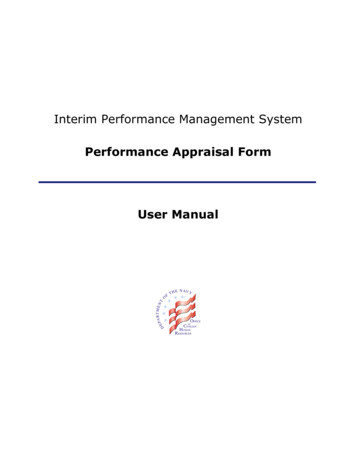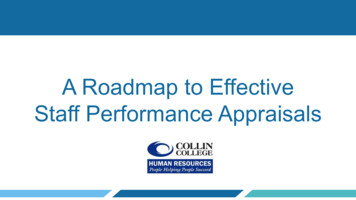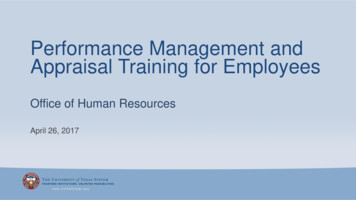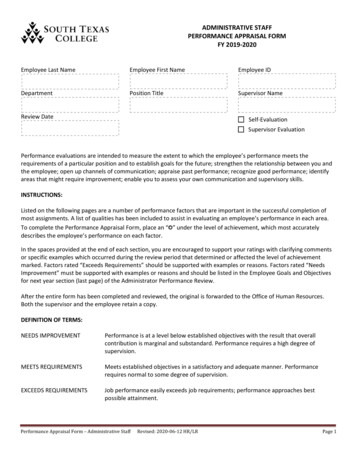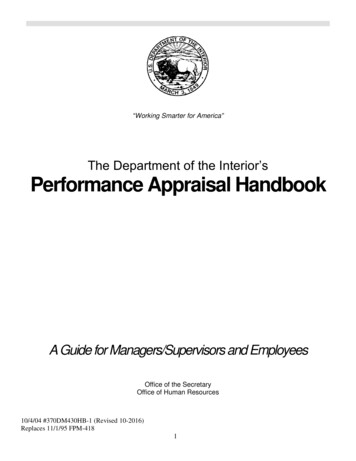
Transcription
Identification of Employee Performance AppraisalMethods in Agricultural OrganizationsVenclová Kateřina, Šalková Andrea, Koláčková GabrielaAbstractA formal employee performance appraisal is regarded as one of the tools of human resourcesperformance management. People, their knowledge and skills are currently considered to be themost valuable resource a company has. The article focuses on methods of employee performanceappraisal in agricultural organizations in the Czech Republic. The first part of the article dealswith the theoretical background of the term “formal appraisal” and employee performance appraisal methods as defined by Czech and foreign specialists. Further, the article describes, basedon a questionnaire survey, employee performance appraisal methods that are considered important for the agricultural organizations in the Czech Republic. The aim of the article is to identifythe current state of formal employee appraisal in a sample group of agricultural organizationsand to test dependencies between selected qualitative characteristics. The outcomes show thatthe most commonly used methods of employee performance appraisal in agricultural organizations include predefined goal-based performance appraisal, predefined standard outcome-basedperformance appraisal and appraisal interviews. Agricultural organizations apply these methodsin particular due to the fact that their findings are further utilized in other areas of humanresource management, such as reward system and personnel planning. In statistical terms, dependency between the method of employee performance appraisal according to predefined goalsapplied by agricultural organizations and personnel planning (an area of human resources management) has been proven (p-value: 0.032, Phi coefficient: 4.578).Key words: agriculture, organization, employee appraisal, appraisal methods, employee1. INTRODUCTIONAt present, people, their knowledge and skills are considered to be the most valuable resourcea company has, therefore it is necessary not only to reward and develop them (Hroník, 2006;Koubek, 2007; Banfield & Kay, 2008; Bělohlávek, 2009; Plamínek, 2010), but also to evaluatethem, since employee performance appraisal together with reward system represent an importantpart of employee performance management (Dessler in Kondrasuk, 2011; Palailogos, Popazekos,Panavotopoulou, 2011; Lussier & Hendon 2012; Snell & Bohlander 2012).Formal employee performance appraisal is an evaluation process through which managers evaluate, compare and provide feedback on employee performance (Kocianová, 2010; Giangrecco,Carugati, Sabastino, Al Tamini, 2012, Murphy & Cleveland in Spence & Keeping, 2011) andmanage human resources in an organization (Roberts, 2003; De Andrés, García – Lapresta,Gonzáles Pachón, 2010).Employee performance appraisal is valuable for the organization, the manager as well as for theemployee evaluated. Appraisal efficiency is determined by selected appraisal criteria, selected ap20joc 2-2013 v4.indd 20Journal of CompetitivenessVol. 5, Issue 2, pp. 20-36, June 2013ISSN 1804-171X (Print), ISSN 1804-1728 (On-line), DOI: 10.7441/joc.2013.02.0226.6.2013 11:46:27
praiser/s, selected appraisal methods and the quality of their application (Lukášová, 2010).Knowledge regarding the specific HRM challenges farms are currently facing, and even theirspecific HRM practices and strategies, is limited. Identifying and structuring HRM practices andrelated risk in animal agriculture are important to help frame questions and provide empiricalgrounding for future in-depth research of agriculture HRM (Bitsch, Kassa, Harsh and Mugera,2006). Agribusiness managers have little to rely on, when developing personnel policies andprocedures for a growing business. Practices developed for large corporations often times do notscale down well to smaller businesses or may not fit the agricultural or agribusiness environment(Bitsch, 2009).The number of employees as of 31 December 2011 in agricultural, forestry and fishing sector(according to CZ-NACE) amounted to 151,200, which represents 3.1% of the overall numberof employees involved in the national economy (NE) of the Czech Republic. This section ranks9th (out of 19 sections as defined by CZ-NACE) as far as employment in the NE of the CzechRepublic is concerned (Czech Statistical Office [CZSO], 2011).The need to address the issue of human resources in agriculture resulted from the differentposition of agriculture to other sectors. The other need was the lack of information on humanresource management (performance appraisal as an integral part of human resource management) in agriculture. This fact is supported by a few experts (Bitsch, Kassa, Harsh and Mugera,2006; Bitsch, 2009).The aim of this article is therefore the identification of the current state of formal employeeappraisal in the sample group of agricultural organizations, based on analysis of survey dataand testing of dependencies between selected qualitative characteristics that relate to the issuesexamined.The article was produced on the basis of an analysis of primary and secondary sources, in particular research articles focusing on employee performance appraisal. Primary data is derivedfrom a questionnaire survey carried out to explore the use of performance appraisal methods inagricultural organizations in the Czech Republic.2. THEORETICAL BACKGROUNDPerformance management can be defined as a systematic process for improving organizationalperformance by developing the performance of individuals and teams (Armstrong, 2012). Performance management is the system through which organizations set work goals, determineperformance standards, assign and evaluate work, provide performance feedback, determinetraining and development needs and distribute rewards (Briscoe & Claus, 2008). Performancemanagement is a process involving performance planning, performance managing, performanceappraisal, performance rewarding and performance development (Deb, 2009). Performance appraisal can be defined as the formal assessment and rating of individuals by their managers(Armstrong, 2012).2.1 Formal employee performance appraisalEmployee performance appraisal has two forms – formal (systematic) and informal (non-systematic) appraisal.21joc 2-2013 v4.indd 2126.6.2013 11:46:27
Informal appraisal means continuous evaluation of an employee by her/his superior during thework process (Dědina & Cejthamr, 2005). Formal employee appraisal is a formal organizationalprocess conducted on a systematic basis in order to enable a comparison between the expectedindividual (group) and real performance (Giangreco et al, 2012). Formal appraisal consists ofseveral phases and selected methods according to appraisal areas (Bělohlávek, 2009).According to Kondrasuk (2011) formal appraisal may be defined as follows: A tool or a mode that evaluates the work performance of an employee. An interview in the course of which an employee’s work performance is evaluated and theemployee is given feedback. A system of determining an employee’s work prospects/current work performance /evaluated performance/feedback provided to employees through performance appraisal and thepossibilities of its future improvement/determining new goals and expectations for anotherperiod. A part of performance management.2.2 Employee performance appraisal methodsThe intention to find an optimal way of employee performance appraisal led to the developmentof a number of methods. Methods differ in terms of their laboriousness, time demands, costs andusability, e.g. for the purposes of reward of employees subject to the appraisal. A significant criterion for the distinction of methods and their suitability for specific situations is time or whetherthe method is aimed at the evaluating of work already carried out or the identification of futureresults. Further, it is possible to classify appraisal methods according to the area of appraisal theycover and the time horizon they focus on.2.2.1 Classification of employee performance appraisal methods based on the time factoraccording the Czech authorsThree groups of methods may be distinguished according to the time horizon (see Tab. 1): methods focusing on the past that are targeted at past events; methods focusing on the present statethat evaluate the current situation and methods focusing on the future that are oriented towardsfuture forecasts (Hroník, 2006). A similar system of method classification is also recognised byDvořáková (2012) who categorises methods according to the time criterion and distinguishesbetween methods concentrating on work already performed (on the past) and methods concentrating on the future and identifying the development potential of employees.Methods focusing on the past have the advantage of dealing with work already done and aretherefore relatively measurable. The disadvantage of this method is the impossibility of resultalteration. Employee performance appraisal oriented towards the future focuses on future performance (Duda, 2008).22joc 2-2013 v4.indd 22Journal of Competitiveness26.6.2013 11:46:27
Tab. 1 - Appraisal methods according to the time perspective as categorised by Czech authors.Source: Own data processed based on information obtained from selected publications (Hroník2006; Duda 2008; Dvořáková 2012)Methods focusingon the pastMethods focusing Methods focusingon the presenton the futureHroník – X, Dvořáková – Y, Duda - ZCritical Incident MethodXYZAssessment/Developmentcentre360 degree feedbackManagement by ObjectivesYPredefined Standard Fulfilment based PerformanceAppraisalYChecklistYZRating ScalesYZBehaviorally Anchored RatingScaleYConfidential ReportYPaired ComparisonYZSelf - AssessmentXYZXYZ2.2.2 Classification of employee performance appraisal methods according to foreignauthorsWhile Czech authors primarily concentrate on the categorisation of methods according to thetime criterion, foreign specialists offer more types of method classification. Their classificationis as follows: traditional and modern methods (Deb, 2006; Khurana, Khurana and Sharma, 2010; Randhawa, 2007), objective methods or performance-oriented methods and judgmental methods (Griffin,2012; Pride, Hughes and Kapoor, 2012), scaling methods, narrative methods (Mathis & Jackson 2011), comparative, rating, narrative and behavioural methods (Bogardus, 2007; Schermerhorn,2011) (Tab. 2).According to these authors, traditional methods cover methods focusing on performance –paired or group comparisons, rating scales and reports, questionnaires, a critical/key incidentmethod, etc. When compared to the classification by Czech authors, there is a link betweenthis classification and the method categorisation according to the time factor, more specificallywith methods focusing on the past, i.e. on work already performed. On the other hand, modernmethods are partly similar to methods focusing on the future that estimate an employee’s development potential. Authors promoting this type of method categorisation (Deb, 2006; Khurana23joc 2-2013 v4.indd 2326.6.2013 11:46:27
et al, 2010; Randhawa, 2007) consider the following methods to be modern ones: Managementby Objectives, Assessment Centre, BARS, 360 degree feedback, and human resources accounting. Similarly like Czech authors, foreign authors also differ in their opinions on method classification as well as the grouping of these methods. Thus performance-oriented and judgmentalmethods also include methods that other authors classify as traditional or modern. As Griffin(2012) states, performance-oriented methods are targeted at the evaluation of current outputsand employee is assessed under standardized conditions, while judgmental methods incorporaterating and ranking techniques (BARS method, rating scales, employee ranking and comparison).Rating methods, according to Mathis and Jackson (2011), include checklists, graphic rating scalesand the BARS method. Narrative methods are used in cases requiring written or oral appraisal(they include the free essay (description) and critical/key incident methods (Mathis & Jackson,2011). The last group, as defined by foreign authors, consists of comparative, rating, narrative,and behavioural methods. Comparative methods compare work performance of individuals– the most common type is the paired comparison, ranking, forced distribution method andforced choice method. According to Bogardus (2007), the most common appraisal methods arechecklists and rating scales. Narrative methods require description of the work performance ofan employee by a manager, they include the essay or free narration method, the critical/key incident method and the confidential report. The group of behavioural methods covers the BARSmethod (Bogardus, 2007).Tab. 2 – Classification of appraisal method according the foreign authors. Source: Own dataprocessed based on information obtained from selected publications (A - Deb, 2006; C – Randhawa, 2007; G – Bogardus, 2007; F – Mathis & Jackson, 2011; Schermerhorn, 2011B – Khuranaet al, 2010; D – Griffin, 2012; E – Pride et al, 2012)AuthorsABCRanking MethodXXXPaired ComparisonXXXRating ScalesXXXForced Choice MethodXXXForced Distribution MethodXXXEssay MethodXXXGroup Appraisal MethodXCritical Incident MethodXXXField ReviewXXXConfidential ReportsXXXXXDEFGHTraditional MethodsChecklistPerson to Person Comparison24joc 2-2013 v4.indd 24XJournal of Competitiveness26.6.2013 11:46:27
Modern MethodsManagement by ObjectivesXXXAssessment CentreXXXHuman Resources AccountingXXXBehaviourally Anchored RatingScaleXXX360- degree feedbackXXXPsychological AppraisalsXJudgmental MethodsBehaviorally Anchored RatingScaleXRating ScalesXRankingXRatingXXScaling MethodsChecklistXGraphic Rating ScalesXBehaviorally Anchored RatingScaleXNarrative MethodsFree Essay MethodXXCritical Incident MethodXXConfidential ReportsXComparative MethodsPaired ComparisonXRankingXForced Distribution MethodXForced Choice MethodXXXRating MethodsChecklistXRating ScalesXBehaviorally Anchored RatingScaleXXBehavioural MethodsBehaviorally Anchored RatingScaleX25joc 2-2013 v4.indd 2526.6.2013 11:46:27
2.2.3 Description of selected employee performance appraisal methods according toCzech and foreign authorsDespite opinion differences in the method classification, both Czech and foreign authors havemutually contributed to the development of descriptions of selected methods.Predefined goals based performance appraisal is a method where an employee concludes anagreement with his superior regarding the main goals of his/her work for a certain period oftime; a plan is developed specifying how and when the goals are to be fulfilled and criteriaare determined to check the accomplishment of the goals and the progress towards the goalis regularly monitored until the expiration of the period agreed upon (Dvořáková, 2012). Themethod evaluates the accomplishment of predefined comprehensive and partial goals that arein harmony with the organization’s goals. These are determined during discussions between theemployee and the superior (Rőmer, 2006).In the process of appraisal based on a critical incident or using the Critical Incident Method(Duda 2008; Hroník 2006) or the Critical Incident Technique (Wagnerová, 2008; Bogardus,2007; Durai, 2010), the appraiser is obliged to keep written records on positive and negativeactions related to the work of the employee in question (Durai, 2010). The appraiser marks anysuccessful or unsuccessful act of each employee, is able to detect, in the course of the appraisalprocess, any critical incident and notify the employee there of (Bogardus, 2007).Rating scales is the most commonly applied method (Dvořáková, 2012). Rating usually meansevaluating the performance and behaviour of an employee according to a predefined scale(Hospodářová, 2008). This method is simple, unambiguous and permits fast appraisal of severalemployees at a time. The appraiser reviews the employee performance and creates scales thatcontain groups of features (factors) and the scope of expected performance for each of the features (Durai, 2010).The Behaviourally Anchored Rating Scale (BARS) method appraises behaviours necessary forthe successful performance of work. It focuses on the approach to work, adherence to workprocedures and usefulness of an employee’s performance (Kocianová, 2010). The BARS methodmeasures employee performance in several areas, such as the quantity and quality of work or thefulfilment of tasks. It describes an efficient and non-efficient performance in each area (Sims,2002).The 360 degree feedback method or the 360-degree multi-criteria appraisal of performance provides a comprehensive, multi-level overview of employee performance (Hospodářová, 2008). It isa systematic collection of data and feedback on the performance of individuals or groups and thetechnical measurement of behaviours and competencies of individuals or groups in the process offulfilment of predefined goals (Ward, 1997). The Ranking is based on the principle of employeeranking according to their relative value for the organization as compared with other employees(Durai, 2010). This method orders all tasks according to their level of significance and each taskthen becomes more or less important than the previous one (Kumar, 2011). Methods based onemployee ranking according to their work performance lie in the comparison of performance oftwo or more individuals. The most common example is alternate comparison (the appraiser firstchooses the best and the worst employee and follows the procedure until all employees are put onthe list), paired comparison (the appraiser compares the first employee with the second employeeon the employee list choosing a certain criterion, then with the third and so on and determines thebetter one in each of the pairs) and Forced Distribution (Koubek, 2007).26joc 2-2013 v4.indd 26Journal of Competitiveness26.6.2013 11:46:27
3. ARTICLE OBJECTIVES AND METHODOLOGYThe main aim of this article is to identify, based on a quantitative survey, the current state offormal employee performance appraisal in agricultural organizations in the Czech Republic. Apartial goal of the article is to test dependencies between selected qualitative characteristics relating to employee performance appraisal.The article has been prepared using the analysis of secondary resources (scientific publicationsand articles from specialised databases, such as Emerald, ScienceDirect and ProQuest) and primary resources in the form of results of the quantitative survey conducted in a sample group ofagricultural organizations in the Czech Republic.Primary data was obtained by a questionnaire survey which took place from June to September2012. Questionnaires were sent electronically using the LimeSurvey application. They weredistributed among legal entities whose purpose of business is agriculture and that operate in theCzech Republic. 1,698 organizations were addressed and the questionnaire was completed by 332respondents (by HR managers, managers and owners). In addition, the first question contains ashort explanation of formal appraisal system. The questionnaire return rate was 19.6%. 73.8 %of these organizations were small businesses (with up to 50 employees), 25.9% were mediumsized businesses (from 51 to 249 employees) and 0.3% were large businesses (with more than 250employees). Czech businesses accounted for 96.1%, while Czech businesses with foreign participation and foreign businesses represented 2.7% and 1.2% respectively. In terms of legal form,the most commonly represented companies were limited liability companies (35.8%), followedby co-operatives (26.8%) and joint stock companies (22.9%).Out of these 332 respondents, only 41 organizations (12.3%) stated that they used formal employee performance appraisa
A formal employee performance appraisal is regarded as one of the tools of human resources performance management. People, their knowledge and skills are currently considered to be the . them, since employee performance appraisal together with reward system represent an important part of employee performance management (Dessler in Kondrasuk .
